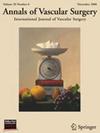Management of Infectious Aortic Aneurysms: Short- and Mid-TermOutcomes
IF 1.4
4区 医学
Q3 PERIPHERAL VASCULAR DISEASE
引用次数: 0
Abstract
Background
Infectious aortic aneurysms are a rare but life-threatening condition due to their rapid development. Their management is multidisciplinary. The main purpose of this study was to evaluate the mortality of patients treated for infectious aortic aneurysm (IAA) by different types of treatments. Secondary objectives were to evaluate infectious recurrences and the factors influencing mortality with this management.
Methods
Between September 2009 and October 2023, all the patients with an IAA confirmed by the clinical, biological, microbiological, radiological, and nuclear medicine data were included. Standard treatment included preoperative and postoperative antibiotics and open radical surgery with reconstruction using biological material. Endovascular treatment was used in patients with contraindication to open surgery. An alternative “bridge” technique was proposed in emergencies and consisted of the placement of a covered stent graft followed by secondary open surgical reconstruction. The clinical, biological, bacteriological, and imaging data were collected in the Retrospective and Prognostic Registry of Aortic Infections registry, with a 30-day, 1-year, and 3-year evaluation. Infectious recurrences were studied.
Results
The IAA diagnosis was confirmed in 47 patients with a mean age of 67 ± 10.8 years. Aneurysms were located in the arch (4%), the descending thoracic aorta (21%), the thoracoabdominal aorta (30%), the juxta-renal (4%), and the infrarenal abdominal (41%) aorta. The involved microorganisms were methicillin-sensitive S. aureus (43%), Salmonella (13%), E. coli (9%), and other species (35%). Radical surgery was performed in 27 patients (57.4%): bovine pericardial tubular xenografts and cryopreserved allografts were used in 22 and 3 cases, respectively. Endovascular treatment was performed in 12 patients (25.5%) Medical treatment only was used in 8 cases (17%). The overall 30-day, 1-year, and 3-years survival rates were 78.7%, 52.4%, and 44.4%, respectively. In the radical surgery group, survival rates were 84%, 75.6%, and 60.6%, respectively, vs. 91.7%, 41.7%, and 20.8% in the endovascular group. In the medical group with persistent infection, survival rates were 37.5% and 0%. The average length of antibiotic treatment was 8 days preoperatively and 3 months postoperatively. Periaortic infectious recurrence was observed in 1 patient.
Conclusion
The combination of medical treatment and radical open surgery is effective in the treatment of IAA. Endovascular treatment yields acceptable results. Medical treatment alone should only be reserved for patients who are inoperable due to a very high short-term mortality.
感染性主动脉瘤的治疗:短期和中期结果。
背景:感染性主动脉瘤(IAA)是一种罕见但危及生命的疾病,因其发展迅速。他们的管理是多学科的。本研究的主要目的是评估不同治疗方式治疗AIA患者的死亡率。次要目的是评估这种治疗方法的感染复发和影响死亡率的因素。材料与方法:2009年9月至2023年10月,纳入所有经临床、生物学、微生物学、放射学和核医学资料证实的AIA患者。标准治疗包括术前和术后抗生素和开放根治性手术与生物材料重建。对有开腹手术禁忌的患者采用血管内治疗。在紧急情况下提出了另一种“桥”技术,包括放置覆盖支架移植物,然后进行二次开放手术重建。临床、生物学、细菌学和影像学资料在REPIA登记中收集,并进行30天、1年和3年的评估。研究了感染复发情况。结果:47例确诊为AIA,平均年龄67±10.8岁。动脉瘤位于弓(4%)、胸降主动脉(21%)、胸腹主动脉(30%)、肾旁主动脉(4%)和肾下腹主动脉(41%)。涉及微生物为甲氧西林敏感金黄色葡萄球菌(43%)、沙门氏菌(13%)、大肠杆菌(9%)和其他菌(35%)。27例(57.4%)患者行根治性手术:牛心包小管移植22例,同种异体冷冻保存移植3例。12例(25.5%)患者行血管内治疗,8例(17%)患者仅行药物治疗。30天、1年和3年生存率分别为78.7%、52.4%和44.4%。根治性手术组的生存率分别为84%、75.6%和60.6%,而血管内手术组的生存率分别为91.7%、41.7%和20.8%。持续感染的医疗组生存率分别为37.5%和0%。抗生素治疗的平均时间为术前8天,术后3个月。主动脉周围感染复发1例。结论:内科治疗与根治性开放手术相结合是治疗AIA的有效方法。血管内治疗产生可接受的结果。只有由于短期死亡率非常高而无法手术的患者才应单独进行药物治疗。
本文章由计算机程序翻译,如有差异,请以英文原文为准。
求助全文
约1分钟内获得全文
求助全文
来源期刊
CiteScore
3.00
自引率
13.30%
发文量
603
审稿时长
50 days
期刊介绍:
Annals of Vascular Surgery, published eight times a year, invites original manuscripts reporting clinical and experimental work in vascular surgery for peer review. Articles may be submitted for the following sections of the journal:
Clinical Research (reports of clinical series, new drug or medical device trials)
Basic Science Research (new investigations, experimental work)
Case Reports (reports on a limited series of patients)
General Reviews (scholarly review of the existing literature on a relevant topic)
Developments in Endovascular and Endoscopic Surgery
Selected Techniques (technical maneuvers)
Historical Notes (interesting vignettes from the early days of vascular surgery)
Editorials/Correspondence

 求助内容:
求助内容: 应助结果提醒方式:
应助结果提醒方式:


